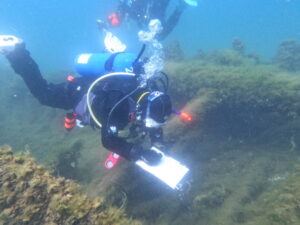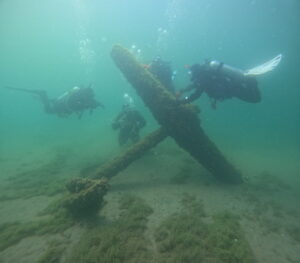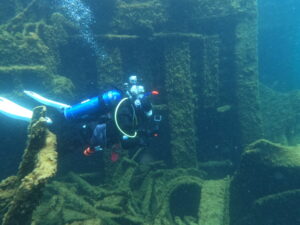The summer mission located in Thunder Bay, MI this year was an amazing experience! We stayed at the Great Lakes Maritime Heritage Center which is located in the Thunder Bay National Marine Sanctuary. TBNMS is part of the National Oceanic and Atmospheric Administration (NOAA), who we worked alongside all week on the 10 dives our group executed.

Maddie records information about an anchor on the wreck of the Flint in Thunder Bay National Marine Sanctuary.
The focus of this trip was to engage in science related to shipwrecks in the Great Lakes (specifically Lake Huron). The water was extremely cold, but the shipwrecks underwater were worth the freezing temperatures.
These shipwrecks varied in size and shape, background, location, etc. Each one had a story to tell about where it came from or why it sank. It was so incredible to experience the cold-water diving, which is something most Nauts are not used to, since most SCUBAnauts opportunities to dive are located in the warmer waters.
To be able to go on this summer trip, we needed to get drysuit certified. This meant multiple dives prior to the trip to get comfortable in the suit, and lots of practice with buoyancy and all of the new challenges. The Great Lakes waters were far too cold for a wetsuit!
The Big Anchor Project
While on our trip, we partnered with a few NOAA researchers to help with underwater projects they were working on. One of these research projects was locating and measuring underwater anchors to document for the Big Anchor Project. This is an organization that allows anyone in the world to document historic anchors with their size, background, location, etc.
We got the chance to measure and collect data from multiple anchors underwater at different shipwrecks. Then, the information was entered into the Big Anchor database, with the credit going to SCUBAnauts International! We documented two anchors on the Flint wreck, one on the Ogarita, and one that is not on a wreck. As far as we know, we were the first people to document this new anchor!
Photogrammetry
Another interesting thing that they work on at the TBNMS is called photogrammetry. Underwater 3D photogrammetry is the process of photos being combined to create an underwater map of the seafloor or sunken structures. These can be turned into 3D models, using 2D images taken from videos on a GoPro. We split into two teams with each team carrying a GoPro, and our group would map out and record the shipwreck to get a full video of the top of the shipwreck.
You always had to stay around 10 feet above the shipwreck to get a good view, and there must be some overlap for the photogrammetry software to recognize the frames. It was so fun to see how our 3D models came out after taking our shipwreck footage!
I really enjoyed this summer trip and getting to know all the Nauts that joined me. If this is to be a regular SCUBAnauts summer mission, I would highly recommend this trip to anyone focused on archaeology and shipwrecks. It educated me on topics that I wasn’t even aware about such as photogrammetry and the Big Anchor Project.
This was a very fun, yet challenging experience, and it was enlightening to learn all about what NOAA and TBNMS are doing to preserve the historic shipwrecks and the Great Lakes!
— Maddie M., 1st Class Naut, Savannah Chapter



